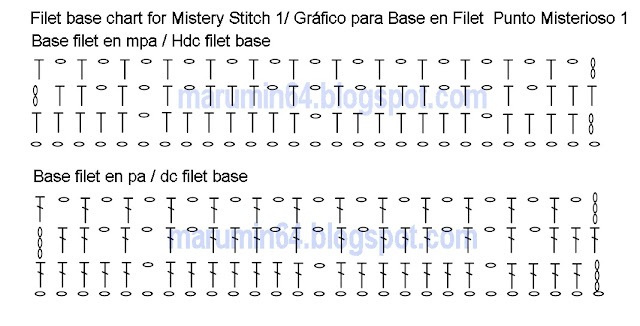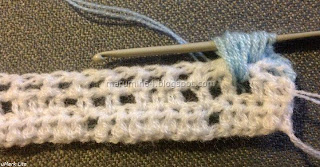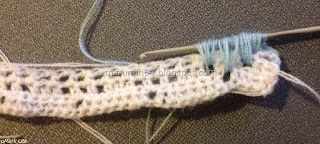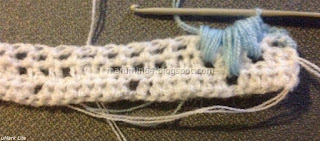Aquí está el paso a paso para el segundo Punto Misterioso. La base que utilizamos es la misma que para el Punto Misterioso 1, la diferencia radica en la posición en que se "bordan" el primer y último grupo de lazadas que formarán nuestras "hojitas". Al igual que en el Punto Misterioso 1, la base de filet puede realizarse en punto alto o medio punto dependiendo del efecto que se quiera lograr. En la foto de abajo,ambas muestras están tranajadas con el mismo hilo y tamaño de ganchillo, pero la muestra de la izquierda está trabajada con medio punto, mientras que en la de la derecha utilizamos punto alto.
Here is the step by step for the second variation of the Mistery Stitch. We use the same "filet" base as for the first variation, the only difference being the position in which we "embroider" the first and last set of loops. that create our "leaves". As for the Mistery Stitch 1, the filet base used can be worked in double crochet or half double crochet depending on the desired appearance.
In the picture below, both samples are worked using the same yarn and hook size, but the sample on the left is worked on a hdc base (rounder appearance), while the sample on the right uses a dc base.
Comenzamos trabajando las 3 vueltas de base filet en mp o pa según se desea.
Begin by working the three rows for the filet base (instructions on previous blog) using either double crochet or half double crochet
Trabajamos ahora dos cadenas (o 3) para dar la altura, mp en el sgte. pto y 2 mp en el pto sgte. Levantamos 2 cadenetas.Work 2 chains (or 3 if working with dc) to turn, hdc in next stitch, 2hdc in next. Ch2
En ese mismo punto introducimos el ganchillo para comenzar con el primer grupo de lazadas, tomamos lazada, estiramos, tomamos otra lazada y volvemos a insertar el ganchillo en el mismo punto. Realizamos esta operación de 3 a 4 veces según el efecto que se desee.
Insert hook in same stitch as last hdc, yo, pull lightly to desired length, yo, reinsert hook in same space, repeat once or twice more depending on desired effect..
Ahora insertamos el ganchillo en el espacio a la izquierda y una línea más abajo del que trabajamos con anterioridad, repetimos las lazadas...Insert hook in same stitch as last hdc, yo, pull lightly to desired length, yo, reinsert hook in same space, repeat once or twice more depending on desired effect..
Now, insert the hook one space to the left and row down from the previous stitch, yo, pull up loop to desired length, repeat twice more..
Para el tercer bloque, introducimos el ganchillo en el cuadradito a la izquierda y una vuelta más abajo, como muestra la foto..
Begin the third group of loops one row below and one space to the left of the previous group..
Para el cuarto bloque de lazadas introducimos el ganchillo un espacio a la izquierda y una vuelta más arriba del grupo recién trabajado..
For the fourth loop, go one space to the left and one row up..
Finalmente, el último grupo de lazadas, se "borda" un espacio a la izquierda y en la última vuelta del trabajo. Tomamos una última lazada y cerramos todos los puntos juntos.
For the last group, insert hook one space to the left and work in the top row... Once you complete all the groups, yo, and pull through all loops on hook at once.
Levantamos 2 cadenetas y trabajamos 3 mp en el mismo espacio donde realizamos el último grupo de lazadas.
Chain 2, and work 3 dc in same space as last group of loops
Ch 2, and begin working next "leaf". To work the first group of loops insert hook in space last worked. Continue working this pattern to the end of the row. Finish with ch, 2 dc in next st, and 1dc in each of last 2 sts. (Refer to the graphic below)


















.jpg)
.jpg)
.jpg)
.jpg)
.jpg)
.jpg)
.jpg)
.jpg)
.jpg)
.jpg)
.jpg)
.jpg)




